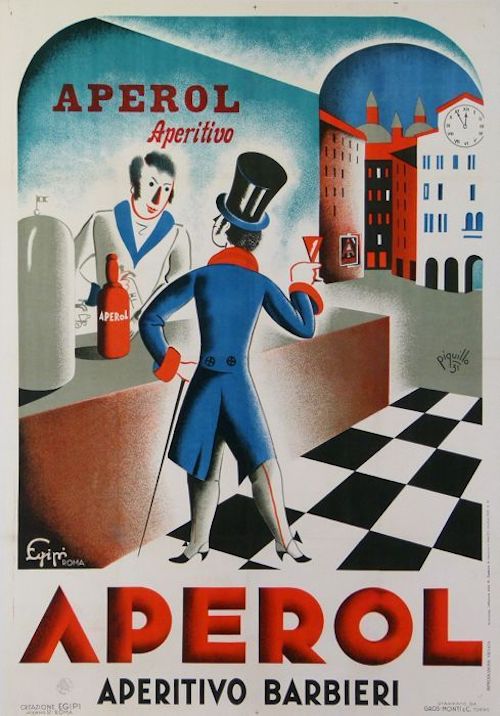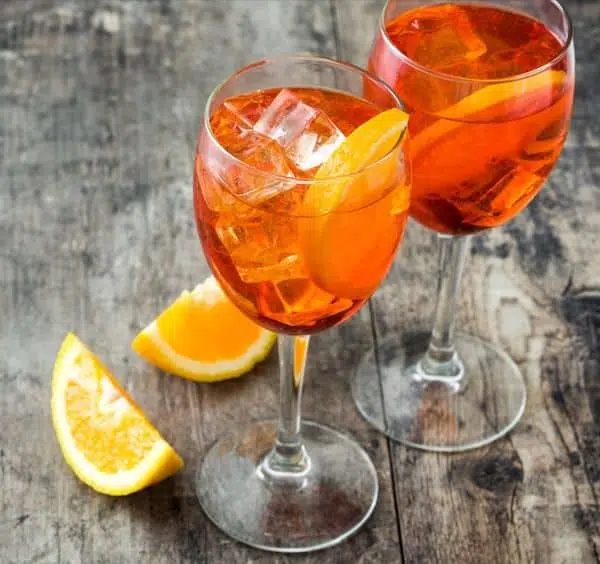The Spritz cocktail has its roots in the region of Veneto, Italy. In the late 1800s, Austrian soldiers diluted their white wine with a spritz (German for "splash") of water. This made the drink lighter and easier to drink.
Over time, the Northern Italians tweaked the recipe for Spritz drinks. Water was replaced with sparkling water to make it more refreshing. Fortified wines and Amaro liqueurs are added as is Prosecco.
During the 1950s, the Aperol Spritz cocktail was invented by the brothers Luigi and Silvio Barbieri in Padua, Northern Italy and is a fixture in Italian aperitivo drinks ever since.
Jump to History | When was it invented? | When did Spritzes become popular? | "Spritz", "Spritzer", and "G'Spritzter" | Traditional formula | Why are they popular in Italy? | Modern variations | Recipe | FAQs
History of the Cocktail
Although the cocktail originates in Italy, the German sound of the name indicates it's not an entirely Italian creation. In fact, Austrian troopers brought the idea of the Spritz to the Veneto region in Northern Italy in the 1800s. At the time, the territory belonged to the Austrian Empire. [1]
Austrian soldiers, who were not used to the high alcohol content of Italian wine, diluted it with water. By that, they got an alcohol percentage similar to beer. This first version of a "Spritzer" consisted of equal parts soda water and wine.
As the cocktail evolved, the recipes changed, and Italian ingredients were added. A Venetian Spritz, for instance, now usually contains Prosecco, a bitter aperitivo, and soda water.
It took quite a long time for the cocktail to travel across the Atlantic. In the early 2000s, the Campari group, also owning Aperol, brought the "Spritz" to the United States and promoted it as the go-to drink at many events.
That marked the starting point for the Spritz to be one of the most famous summer drinks.
When and where was the Aperol Spritz invented?
The Aperol Spritz cocktail came up in the 1950s in Northern Italy. The base ingredient Aperol was introduced in 1919 by the Barbieri brothers in their home town Padua, a small town in the Veneto region.
In the 1950s, the Veneto region in general, and Venice in particular, was the epicenter of fashion & food lifestyle. It was the perfect time for an Aperol Spritz to convince the Paduan upper class and the Italian high society. The light and refreshing drink quickly became a popular aperitif and soon after also a sunset sip. [2]

When did Spritzes become so popular?
What really pushed the popularity of the Spritz cocktail was a famous marketing campaign launched in the 1990s.
The ads showed young and joyful people enjoying daytime Spritzes. The Slogan of this campaign, "easy, breezy" promoted the drink as an after-work sip to unwind from a difficult day at the office.
At the same time, probably supported by Aperol, bartenders across major Italian cities began serving the drink at their venues. Due to the low alcohol content, they promoted Spritzes as an easy step on the way to lower alcohol consumption.
It didn't take long for the Italians and visitors from surrounding countries to fall in love with the light and fresh summer drink.
The meaning of "Spritz", "Spritzer", or "G'Spritzter"
In Austria, ordering a "G'spritzter" will get you a glass of wine mixed with soda water, typically in a 1:1 ratio. G'spritzer is also the original word for the drink, not Spritzer or Spritz. It's just too hard to pronounce for non-German speakers.
Present in every recipe, and the reason for the name of the cocktail, is soda water. "Spritzer" means a splash of something, like in "a splash of water" - "ein Spritzer Wasser".
Many people claim that people in German-speaking areas of Europe use the term as a synonym for drinks containing soda water or carbonated lemonade. However, that's not correct. Spritzer is the English word for terms like G'Spritzer (Austrian) or Schorle, its German equivalent.
Traditional recipe formula
The Spritz is a combination of bubbly Prosecco, soda water, and bitter aperitifs like Campari or Aperol. The slightly bitter but refreshing mix takes the tastebuds on a fun rollercoaster.
The recipe recommends a simple 3:2:1 approach: it consists of three parts Prosecco, two parts Aperol and one part soda water.
Aperol made enormous efforts to establish their version of a perfect Aperol Spritz. It is still one of the famous versions of a Spritz. Their formula is somewhat common knowledge and a standard offer in many places.
Modern variations
Today, the recipes become more diverse as new and creative interpretations are constantly arising. Still, the 3:2:1 approach remains a great guide to achieving a well-balanced Spritz cocktail.
While Prosecco and soda water are indispensable, the bitter aperitif often is replaced with something else. That can be other Amari, aperitifs, liqueurs, high-percentage spirits, juices, or a mix of the above. Try, for instance, our Amaro Spritz based on two different Amaro liqueurs or this non-alcoholic Spritz for a hangover-free alternative.
Why are Spritz cocktails so popular in Italy?
In order to comprehend why this light and sparkling drink became so successful in Italy, you must understand the Italian lifestyle. Living the "dolce vita" means indulging in all the good things in life.
First and foremost, this means indulging in wine and food. That is also reflected in the many courses Italians eat for dinner, which typically start with an Aperitivo cocktail to stimulate appetite. [3]
Spritz cocktails in general are perfect for this for many reasons. First, they're light, well-balanced, and refreshing. Second, the herbal infusions in Amaro liqueurs are excellent for stimulating appetite.

Equipment
- 1 Jigger
Ingredients
- 3 oz Prosecco
- 2 oz Aperol
- 1 oz Soda water
- 1 Slice of orange
Instructions
- Chill a wine glass by filling it with ice cubes.
- Add the Prosecco, Aperol, and soda water to the glass.3 oz Prosecco, 2 oz Aperol, 1 oz Soda water
- Garnish with a slice of orange.1 Slice of orange

